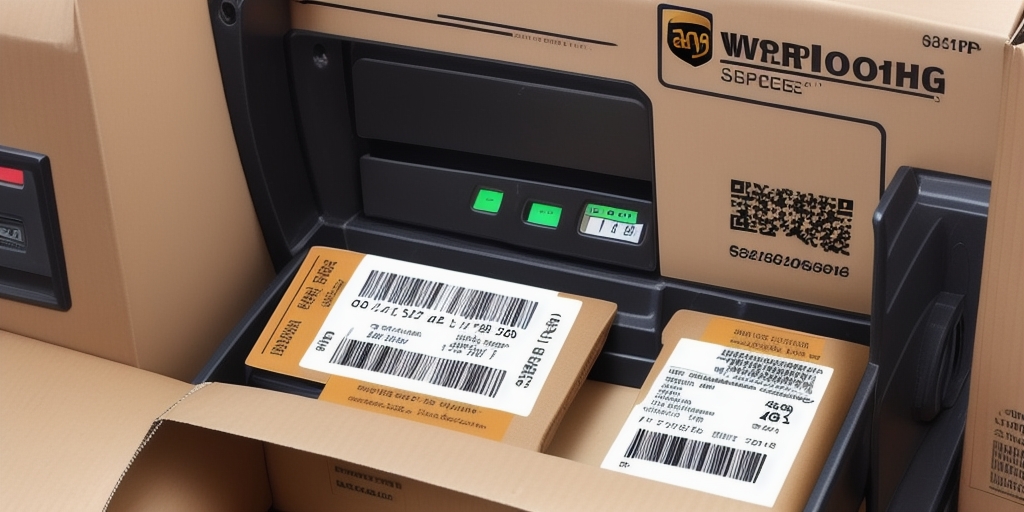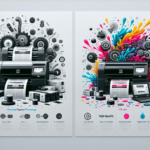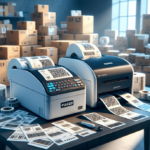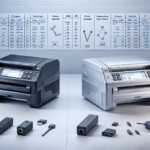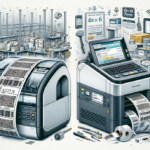Overview of Label Printers Compatible with UPS WorldShip
For businesses that regularly ship products, selecting the right label printer is crucial to ensure efficiency and accuracy. UPS WorldShip is a comprehensive shipping software that integrates seamlessly with various label printers, enabling streamlined operations. Below are some of the top label printer options compatible with UPS WorldShip:
Zebra ZP450
The Zebra ZP450 is a popular choice among small to medium-sized businesses. Known for its reliability and compact design, the ZP450 offers high-quality label printing with fast speeds of up to 6 inches per second. Its user-friendly interface makes it easy to set up and maintain, reducing downtime and increasing productivity.
DYMO LabelWriter 4XL
The DYMO LabelWriter 4XL is renowned for its versatility and compatibility with both Windows and Mac OS. It boasts a fast printing speed of up to 53 labels per minute and can handle a variety of label sizes, making it ideal for businesses with diverse labeling needs.
Rollo Label Printer
The Rollo Label Printer offers high-quality, monochrome label printing at an affordable price point. Compatible with both Windows and Mac OS, the Rollo is praised for its ease of use and ability to handle high-volume printing without compromising on speed or quality.
Zebra GX430t
Designed for high-volume printing, the Zebra GX430t is ideal for industrial settings. It supports a range of connectivity options, including USB, Ethernet, and Bluetooth, and offers thermal transfer technology for durable, long-lasting labels.
Brother QL-820NWB
The Brother QL-820NWB is known for its versatility, capable of printing labels in various sizes and formats. It features wireless connectivity and can be controlled via a mobile app, providing flexibility for businesses that need to print labels on the go.
Benefits of Using a Label Printer with UPS WorldShip
Integrating a label printer with UPS WorldShip offers numerous advantages that can significantly enhance your shipping operations:
Time and Cost Efficiency
Label printers are designed to produce labels faster than standard inkjet printers, enabling businesses to handle high shipping volumes with ease. For instance, the DYMO LabelWriter 4XL can print up to 53 labels per minute, drastically reducing the time spent on label generation. Additionally, label printers eliminate the need for costly ink cartridges, providing long-term savings.
Enhanced Accuracy
High-quality label printers ensure that shipping labels are clear and easy to scan, minimizing errors and misdeliveries. Accurate labeling is essential for maintaining customer satisfaction and avoiding unnecessary shipping costs due to misplaced packages.
Seamless Integration
Label printers compatible with UPS WorldShip can be easily integrated into your existing shipping workflow. This integration allows for real-time tracking and management of shipments, providing businesses with better control and visibility over their shipping processes.
Scalability
As your business grows, your shipping needs will evolve. Investing in a scalable label printer ensures that you can handle increased shipping volumes without compromising on speed or quality. Printers like the Zebra GX430t are built to accommodate high-volume demands, making them suitable for expanding businesses.
How to Choose the Right Label Printer for Your Needs
Selecting the appropriate label printer involves assessing your business's specific requirements and evaluating the features of available options. Here’s a step-by-step guide to help you make an informed decision:
Step 1: Assess Your Labeling Needs
- Volume: Determine the number of labels you print daily to choose a printer that can handle your workload.
- Label Size: Identify the range of label sizes required for your shipments.
- Connectivity: Decide whether you need wired (USB, Ethernet) or wireless (Bluetooth, Wi-Fi) connectivity based on your office setup.
- Budget: Establish a budget that includes not only the initial purchase but also ongoing maintenance and supplies.
Step 2: Research Available Options
Explore the features, pros, and cons of different label printers compatible with UPS WorldShip. Reading reviews from reputable sources like PCMag or TechRadar can provide valuable insights.
Step 3: Compare Prices and Features
Compare the prices of different models across multiple retailers such as Amazon, Staples, and Office Depot. Consider factors like warranty, customer support, and return policies.
Step 4: Purchase and Set Up
Once you’ve selected the right printer, proceed with the purchase from a trusted retailer. Follow the manufacturer’s instructions for setup, which typically involves installing software drivers, connecting the printer to your computer or network, and configuring settings within UPS WorldShip.
Step 5: Test the Printer
Before fully integrating the printer into your shipping workflow, perform test prints to ensure everything functions correctly. This step helps identify any issues early on, preventing disruptions in your shipping process.
Setting Up and Integrating Your Label Printer with UPS WorldShip
Proper setup and integration of your label printer with UPS WorldShip are essential for optimal performance. Below are the key steps and tips to ensure a smooth setup process:
Installation of Drivers and Software
Start by installing the necessary drivers and software provided by the printer manufacturer. This ensures that your computer can communicate effectively with the printer. Most manufacturers offer detailed installation guides on their official websites:
Configuring UPS WorldShip Settings
Within UPS WorldShip, navigate to the printer settings to select your newly installed label printer as the default device. Ensure that the label size and format match your printer’s specifications to prevent printing errors.
Calibrating the Printer
Calibrate your label printer to ensure accurate printing. Calibration involves adjusting the printer settings so that the labels are correctly aligned and positioned. Refer to the printer’s manual for specific calibration instructions.
Testing the Integration
After setup, perform a series of test prints to verify that the integration between UPS WorldShip and your label printer is functioning correctly. Check for print quality, alignment, and any potential connectivity issues.
Maximizing Efficiency and Best Practices
To get the most out of your label printer, implement best practices and productivity strategies that enhance your shipping operations:
Batch Printing
Utilize the batch printing feature in UPS WorldShip to print multiple labels simultaneously. This reduces the time spent on individual prints and streamlines the labeling process.
Use of Label Peeler
Invest in a label peeler accessory to expedite the removal of labels from rolls. This tool can significantly speed up the labeling process, especially during high-volume shipping periods.
Regular Maintenance
Maintain your label printer by regularly cleaning and servicing it according to the manufacturer’s guidelines. Proper maintenance prolongs the printer’s lifespan and ensures consistent print quality.
Optimizing Label Layout
Design your labels efficiently by optimizing the layout within UPS WorldShip. Arrange multiple labels on a single sheet if compatible, minimizing waste and reducing printing costs.
Selecting the Right Labels and Understanding Technical Specifications
Choosing the appropriate labels and understanding the technical specifications of your printer are vital for ensuring compatibility and print quality:
Types of Labels
- Direct Thermal Labels: These labels use heat to produce images and are ideal for short-term use, such as shipping labels.
- Thermal Transfer Labels: These require a ribbon to transfer ink onto the label, providing more durable and long-lasting prints suitable for various environments.
Label Size and Material
Ensure that the labels you select match the size requirements of your shipments and are compatible with your printer type (direct thermal or thermal transfer). Common label sizes include 4" x 6" for standard shipping labels.
Technical Specifications
Key technical specifications to consider include:
- Print Speed: Measured in inches per second (ips), higher speeds mean quicker label production.
- Resolution: Higher DPI (dots per inch) results in clearer and more detailed labels.
- Connectivity: Options like USB, Ethernet, Wi-Fi, and Bluetooth determine how the printer integrates with your systems.
Getting the Best Deals and Understanding Warranty
Purchasing a label printer involves not only selecting the right model but also ensuring you get the best value for your investment. Here’s how to secure the best deals and understand warranty terms:
Comparing Prices Across Retailers
Compare prices from multiple retailers such as Amazon, Staples, and Office Depot to find competitive pricing. Additionally, check the manufacturer's website for any exclusive offers or discounts.
Considering Refurbished Models
Refurbished label printers can offer significant savings while maintaining quality. Ensure that refurbished models come with a warranty and are purchased from reputable sellers.
Bulk Purchasing Discounts
If you require multiple label printers, inquire about bulk purchasing discounts from suppliers. This can lead to substantial cost savings, especially for larger businesses.
Understanding Warranty and Return Policies
Before finalizing your purchase, review the warranty and return policies. Most manufacturers offer a standard one-year warranty, but some might provide extended coverage. Ensure that you understand the terms, including what is covered and the procedure for returns or exchanges:
- Warranty Coverage: Covers defects in materials and workmanship.
- Return Policy: Specifies the time frame and conditions under which returns are accepted.
Integrating Your Label Printer with Other Shipping Software Solutions
Many businesses use multiple shipping software solutions alongside UPS WorldShip to optimize their logistics. Integrating your label printer with these systems ensures a cohesive workflow:
Compatibility Checks
Ensure that your label printer is compatible with other shipping software you use. This might involve checking supported protocols or available APIs for seamless integration.
Unified Dashboard
Using a label printer that can be managed through a unified dashboard allows you to oversee all shipping activities from a single interface, enhancing operational efficiency.
Automated Workflows
Set up automated workflows where data from various shipping software is synchronized with UPS WorldShip. This minimizes manual data entry and reduces the likelihood of errors.
Support and Documentation
Refer to official documentation from both the label printer manufacturer and UPS WorldShip to guide the integration process. Additionally, utilize support resources such as forums, help centers, and customer service for troubleshooting.
The Future of Shipping: Why Investing in a Good Label Printer is Essential for Small Businesses Using UPS WorldShip
As the e-commerce landscape continues to expand, the demand for efficient and reliable shipping solutions grows. Investing in a high-quality label printer compatible with UPS WorldShip positions small businesses to meet increasing shipping volumes while maintaining accuracy and professionalism. Advanced label printers offer features like wireless connectivity, faster printing speeds, and enhanced durability, which are essential for scaling operations and delivering excellent customer experiences.
Conclusion
Choosing the right label printer for use with UPS WorldShip is a critical decision that can impact your business’s shipping efficiency and accuracy. By assessing your specific needs, researching available options, and considering factors like cost, compatibility, and features, you can select a printer that best aligns with your operational requirements. Proper setup and integration, combined with best practices in label printing, will ensure that your shipping process is smooth and reliable. Stay updated with the latest advancements in label printing technology to keep your business competitive in the evolving shipping landscape.















